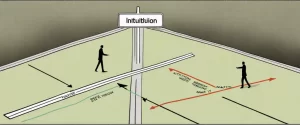—A Mind at Play & Alan Turing
In the ever-evolving landscape of scientific and technological advancements, certain individuals shine as beacons of ingenuity and intellectual curiosity. Two such luminaries, Jimmy Soni and Andrew Hodges, have delved into the lives of two extraordinary minds: Claude Shannon and Alan Turing, respectively. Through their meticulously researched biographies, “A Mind at Play” by Soni and “Alan Turing” by Hodges, readers are granted intimate access into the lives, thoughts, and immense contributions of these two trailblazers.
In “A Mind at Play,” Jimmy Soni delves deep into the life of Claude Shannon, the brilliant American mathematician and electrical engineer. Known for his groundbreaking work in the field of information theory, Shannon’s contributions laid the foundation for modern computer science. Soni takes us on a captivating journey, exploring Shannon’s childhood in Michigan, his unconventional pursuits, and his relentless pursuit of intellectual challenge. From the invention of the digital circuit to his groundbreaking essay on programming a computer to play chess, Shannon’s mind was unrivaled in its ability to merge the abstract with the concrete, leading to profound implications for the modern world.
Turning our attention across the Atlantic, Andrew Hodges guides us through the labyrinthine life of Alan Turing in “Alan Turing: The Enigma.” Turing, a British mathematician, logician, and pioneer of computer science, was hailed as a genius during his time. However, his life was riddled with internal conflicts, stemming from his homosexuality and the tumultuous era in which he lived. Hodges illuminates Turing’s remarkable mind, analyzing his pioneering work in cryptography during World War II, his conceptualization of the Turing machine, and the ethical dilemmas he grappled with in the development of artificial intelligence. As we traverse Turing’s secret life, scientific breakthroughs, and tragic downfall, Hodges unravels the enigma that was Alan Turing, delivering a profound insight into his indelible legacy.
While Soni’s “A Mind at Play” and Hodges’ “Alan Turing: The Enigma” focus on the lives of two extraordinary individuals, these biographies offer much more than just a recounting of their achievements. Both authors delve into the complex nature of genius, juxtaposing the triumphs and struggles these pioneers faced, both personally and professionally. Soni and Hodges weave a rich tapestry of history, science, and psychology, enabling readers to not only grasp the immense contributions of Shannon and Turing but also to probe the fundamental question of what it means to be a visionary in an ever-changing world.
Through this comparative study, we will delve into the remarkable parallels and divergences between Claude Shannon and Alan Turing, examining how their backgrounds, personalities, and professional endeavors shaped their unique approaches to scientific exploration. As we embark on this intellectual odyssey, we will unravel the intricate tapestry woven by Soni and Hodges, celebrating the brilliance and indomitable spirit of these two trailblazers who forever altered the course of human knowledge.
Brief Summary of Two Books
A Mind at Play by Jimmy Soni
“A Mind at Play” by Jimmy Soni is a biography that explores the life and achievements of mathematician and computer pioneer Claude Shannon. The book dives into Shannon’s early years as a curious child, his time as a student at MIT, and his groundbreaking contributions to various fields, including information theory and cryptography. It delves into Shannon’s innovative thinking, his playful approach to problem-solving, and his influential impact on modern technology. The biography reveals the brilliance and uniqueness of Shannon’s mind, highlighting his intellectual curiosity, versatility, and profound influence on the digital age.
Alan Turing by Andrew Hodges
“Alan Turing: The Enigma” is a biography by Andrew Hodges that tells the story of Alan Turing, a British mathematician, logician, and cryptanalyst who played a crucial role in decoding German messages during World War II, ultimately helping the Allies win the war. The book explores Turing’s early life, his groundbreaking work on the concept of computation, and his efforts in code-breaking at Bletchley Park. Despite his contributions to science and his pivotal role in saving countless lives, Turing tragically faced persecution due to his homosexuality. This compelling biography delves into his personal struggles, including his arrest and the tragic circumstances surrounding his death at a young age. Hodges highlights Turing’s legacy and the profound impact his work had on both the fields of mathematics and computer science.
Comparison between Two Books

Similarities in computing, mathematics, and innovation
Both A Mind at Play by Jimmy Soni and Alan Turing: The Enigma by Andrew Hodges delve into the lives and work of influential figures in the field of computing, particularly focusing on the importance of mathematics and innovation. Several key similarities can be observed between the two books:
1. Computing Pioneers: Both books highlight the significant contributions made by Alan Turing to the development of early computers and artificial intelligence. They discuss his groundbreaking work on the concept of a universal machine, now known as the Turing machine, which laid the foundation for modern computing.
2. Mathematical Ingenuity: The books emphasize the central role of mathematics in the work of their respective subjects. Soni’s book explores the mathematical prowess of Claude Shannon, who made groundbreaking contributions to the field of information theory. Similarly, Hodges’ book showcases Turing’s deep understanding and application of mathematics to various computational problems, such as the breaking of the Enigma code during World War II.
3. Innovation and Creativity: Both Turing and Shannon were known for their innovative thinking and creative approaches to problem-solving. The books highlight their ability to think outside the box and challenge conventional wisdom, leading to groundbreaking advancements in computing and communication.
4. Interdisciplinary Connections: Both books emphasize the interdisciplinary nature of computing and its intertwining with various fields, including mathematics, engineering, and cryptography. They explore how advances in one field often sparked progress in another, highlighting the importance of collaboration and cross-pollination of ideas in technological breakthroughs.
5. Legacy and Impact: Both books discuss the lasting impact of Turing and Shannon’s work on modern computing and technology. They highlight the foundational concepts and principles these men introduced, which continue to shape various aspects of contemporary computing, from artificial intelligence to cryptography.
In summary, A Mind at Play and Alan Turing: The Enigma converge in their focus on the central themes of computing, mathematics, and innovation. Both books highlight the contributions of their subjects to these fields, emphasizing their groundbreaking work, creative problem-solving abilities, and lasting legacies in the world of technology and computing.
Divergences in computing, mathematics, and innovation
In comparing “A Mind at Play” by Jimmy Soni and “Alan Turing: The Enigma” by Andrew Hodges, it is evident that both books shed light on the immense contributions of Alan Turing to the fields of computing, mathematics, and innovation. However, there are certain divergences in their approaches and focuses.
One divergence between the two books is their emphasis on different aspects of Turing’s life and work. “A Mind at Play” offers a broader exploration of Turing’s contributions and achievements across various disciplines, including mathematics, computer science, and codebreaking. It delves into his early years, his foundational work in computability theory, and his transformative ideas in artificial intelligence. On the other hand, “Alan Turing: The Enigma” primarily focuses on Turing’s cryptography and codebreaking efforts during World War II, particularly his instrumental role in cracking the Enigma code. While it does touch upon his other mathematical and theoretical advancements, the book provides a more concentrated narrative of Turing’s wartime activities.
Another divergence lies in their writing styles and narrative structures. “A Mind at Play” adopts a more approachable and anecdotal tone, presenting Turing’s life and accomplishments in a narrative style that keeps the reader engaged. It intertwines personal stories, historical context, and technical explanations to provide a well-rounded portrait of Turing’s genius and the impact of his ideas. In contrast, “Alan Turing: The Enigma” has a more academic and detailed approach, delving deeply into the technical aspects of Turing’s work and providing an in-depth analysis of his theories. Hodges, being a mathematician himself, offers a more technical exploration of Turing’s achievements, making the book a dense but comprehensive read.
Regarding the focus on computing, mathematics, and innovation, both books highlight Turing’s groundbreaking concepts and their lasting impact. “A Mind at Play” delves into Turing’s concept of the Universal Turing Machine, his work on computability, and his visionary ideas on artificial intelligence. It explores his influence on the development of computer science, laying the foundation for modern computing. “Alan Turing: The Enigma” also emphasizes Turing’s contribution to the field of computing through his development of the Turing machine, a theoretical computing device that allowed for mathematical problem-solving and became a blueprint for the first computers. It further emphasizes Turing’s legacy in mathematical logic and his pioneering contributions to algorithms and cryptography.
In terms of innovation, both books emphasize Turing’s ability to think outside the box and his groundbreaking ideas that challenged conventional methods. “A Mind at Play” explores Turing’s inventive thinking and his unconventional approaches to problem-solving. It highlights his innovative ideas in the realm of artificial intelligence and his foresight into the possibilities and limitations of machine intelligence. Similarly, “Alan Turing: The Enigma” showcases Turing’s exceptional intellect and his ability to devise ingenious strategies to break complex codes. It underscores his innovative methodologies and showcases how he revolutionized cryptanalysis.
In summary, while both “A Mind at Play” by Jimmy Soni and “Alan Turing: The Enigma” by Andrew Hodges delve into Alan Turing’s contributions to computing, mathematics, and innovation, they differ in their focus and writing styles. “A Mind at Play” offers a broader exploration of Turing’s life, achievements, and diverse influences, while “Alan Turing: The Enigma” primarily concentrates on his wartime cryptography efforts. Additionally, Soni’s book adopts a more engaging narrative style, whereas Hodges’ work provides a more technical and in-depth analysis. Nonetheless, both books highlight the immense impact of Turing’s concepts and innovative thinking in shaping the fields of computing, mathematics, and innovation.

Conclusion
Both books, “A Mind at Play” by Jimmy Soni and “Alan Turing: The Enigma” by Andrew Hodges, offer valuable insights into the life and work of one of the most influential figures in computer science, Alan Turing. However, which book is more worthy of reading would depend on your specific interests and preferences.
“A Mind at Play” by Jimmy Soni provides a comprehensive and accessible overview of Turing’s life and contributions to various fields, including mathematics, logic, theoretical computer science, and artificial intelligence. It explores Turing’s brilliance, his groundbreaking ideas, and his significant impact on modern technology. The book also delves into Turing’s personal struggles and sheds light on his tragic fate. If you prefer a relatively lighter and more engaging narrative that covers Turing’s life in a broader context, “A Mind at Play” would be a suitable choice. And if you want to read another books like it, “The Last Lecture” by Randy Pausch is a good choice
On the other hand, “Alan Turing: The Enigma” by Andrew Hodges is a highly acclaimed biography that offers a more detailed and in-depth exploration of Turing’s life and work. Hodges, a mathematician himself, provides a well-researched and intimate account of Turing’s complex personality, his contributions during World War II, and his pivotal role in the development of early computers. The book delves into the intricacies of Turing’s groundbreaking ideas, including the concept of the Universal Turing Machine and his work on codebreaking at Bletchley Park. If you are looking for a comprehensive and scholarly examination of Turing’s life, “Alan Turing: The Enigma” would be the more appropriate choice.
Ultimately, the choice between these two books depends on whether you prefer a more general overview or a detailed biography. Both books offer valuable perspectives on Alan Turing’s life and legacy, so consider your personal interests and reading preferences to make a decision.



